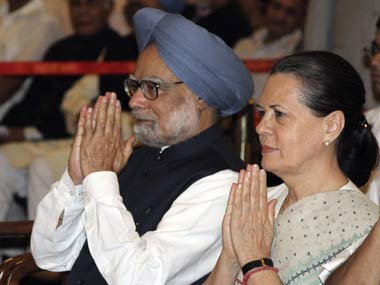If yesterday’s Cabinet reshuffle was intended to signal an end to the drift and downward spiral in governance that has come to characterise the UPA Government, it has already failed in that objective. Barely hours after the swearing-in of the new Ministry at the Rashtrapati Bhavan, the line of ministerial appointees who are less than enthused by their new portfolios – or the fact that they feel slighted by the changes – is growing longer. [caption id=“attachment_40469” align=“alignright” width=“380” caption=“The hope that the reshuffle would signal a revival in the government’s vigour has been dashed. B. Mathur / Reuters”]
 [/caption] Right after the swearing in, Veerappa Moily gave vent to his frustration at having been shunted from the Law Ministry to the Corporate Affairs Ministry. He said he had been made a victim of a “campaign by vested interests” for having pushed for reforms – and that he was being blamed for the “fault of administrative ministries.” Moily was one of two relatively heavyweight Ministers whose portfolios were changed in yesterday’s reshuffle; the other is Jairam Ramesh, who was eased out of the Environment Ministry and moved to the Rural Development Ministry, with a Cabinet rank. The reshuffle has already claimed its first casualty: Gurudas Kamat resigned from the government yesterday, evidently piqued at not having been elevated to Cabinet rank. Although he performed the proforma ritual genuflection to Sonia Gandhi and pointedly mentioned that his resignation should not be construed as “anti-party activity”, the damage has been done. The fact that he did not attend the swearing-in ceremony pointed to the depth of his rancour. According to media accounts, at least two other Ministers - Vilasrao Deshmukh and Srikant Jena - are manifestly displeased with their station in life. Prime Minister Manmohan Singh appears to be making light of such ministerial discontent, noting that in any such exercise, there was bound to be some unhappiness, and that decisions about the Ministry were made with a larger perspective with the nation’s interests in mind. Yet, the surfeit of long ministerial faces is the surest sign that the reshuffle may have already failed to signal the earnestness of purpose that was required from the UPA government. Given the political context in which it came about, it had given rise to the expectation that a government that is stuck in policy paralysis would use the reshuffle to re-energise itself and convey that it means business in the remainder of its term. Having been put on the defensive in recent months following a spate of corruption scandals and a mass movement to set up an effective anti-corruption agency, the Manmohan Singh government needed to change the narrative and show some semblance of governance. A Cabinet reshuffle would have done that if it had been of a big-enough scale, and had set up accountability standards for governance. That hope, it appears, now rests on slippery ground.
[/caption] Right after the swearing in, Veerappa Moily gave vent to his frustration at having been shunted from the Law Ministry to the Corporate Affairs Ministry. He said he had been made a victim of a “campaign by vested interests” for having pushed for reforms – and that he was being blamed for the “fault of administrative ministries.” Moily was one of two relatively heavyweight Ministers whose portfolios were changed in yesterday’s reshuffle; the other is Jairam Ramesh, who was eased out of the Environment Ministry and moved to the Rural Development Ministry, with a Cabinet rank. The reshuffle has already claimed its first casualty: Gurudas Kamat resigned from the government yesterday, evidently piqued at not having been elevated to Cabinet rank. Although he performed the proforma ritual genuflection to Sonia Gandhi and pointedly mentioned that his resignation should not be construed as “anti-party activity”, the damage has been done. The fact that he did not attend the swearing-in ceremony pointed to the depth of his rancour. According to media accounts, at least two other Ministers - Vilasrao Deshmukh and Srikant Jena - are manifestly displeased with their station in life. Prime Minister Manmohan Singh appears to be making light of such ministerial discontent, noting that in any such exercise, there was bound to be some unhappiness, and that decisions about the Ministry were made with a larger perspective with the nation’s interests in mind. Yet, the surfeit of long ministerial faces is the surest sign that the reshuffle may have already failed to signal the earnestness of purpose that was required from the UPA government. Given the political context in which it came about, it had given rise to the expectation that a government that is stuck in policy paralysis would use the reshuffle to re-energise itself and convey that it means business in the remainder of its term. Having been put on the defensive in recent months following a spate of corruption scandals and a mass movement to set up an effective anti-corruption agency, the Manmohan Singh government needed to change the narrative and show some semblance of governance. A Cabinet reshuffle would have done that if it had been of a big-enough scale, and had set up accountability standards for governance. That hope, it appears, now rests on slippery ground.
The ministry of long faces: A shake-up that pleases no one
FP Editors
• July 13, 2011, 12:17:52 IST
The line of ministers who are displeased with their portfolios or their ranks is growing longer. With such a dispirited team, the odds that it will offer better governance are slender.
Advertisement
)
End of Article